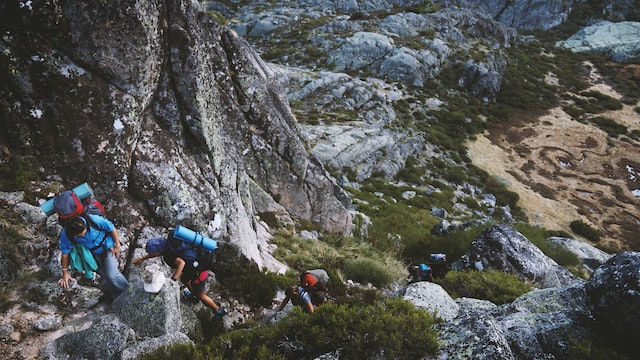The Ultimate Trekking Essentials List When Mountains Are Calling
December 02 2022 – Nysh Website

Aldous Huxley, an English writer from the 1940s, once said “my father considered a walk amongst the mountains as the equivalent of churchgoing”. It does make sense to think that wandering mountain trails is so pure that people follow it like religion. Considering you’re here, it’s safe to say you have a similar perspective toward trekking.
No matter how freeing trekking seems, the thing is that it’s also challenging. In those testing moments, you shouldn’t worry about what you didn’t carry. To save you that trouble, we’ve curated a trekking essentials list. Check it out!
1. Basic Clothing
In order to trek effectively, what clothing you choose to wear becomes extremely important. You have got to dress for the occasion of trekking so that you’re comfortable over an extended period of time.
When picking your outfit for trekking there are 3 factors that make the most difference which is
- Whether your clothes are made of a breathable material
- Do your clothes absorb sweat well enough
- How soon do your clothes dry after a long day of trekking in the snow or rain
For your clothes to achieve these factors, you should ideally opt for dry-fit material because of its sweat-wicking capabilities. But you’ve also got to consider the weather conditions. Here’s a short breakup of what to wear as per the season:
For colder conditions - You should wear 3 layers of clothing during winter. The inner layer can be your thermals. Then comes your second insulating layer for which you can wear a fleece jacket. Your third and final layer should be a breathable coat that is both water and wind-resistant.
For the rainy season - It goes without saying that a water-resistant jacket should be taken along to wear over your dry-fit tee and pants. It is also recommended to carry spare clothes to change in.
For summers - Avoid wearing cotton and go for synthetic materials like nylon or polyester. Even if you feel like wearing shorts, opt for long sleeve t-shirts and pants to protect yourself from the direct rays of the sun, insects, or scratches from weeds.

2. Footwear
There are two kinds of footwear that will get you through any trail and chances are, you already own one of them.
Ankle-Length Trekking Shoes - These are great for tougher terrains where you might be walking on rugged grounds at a point and then even snow at other points. You can pick this for when you’re going on a multi-day trek because the ankle support is fantastic to keep you going.
Hiking Sandals - You can carry hiking sandals if you’re going on a very short and easy trek. You should pack hiking sandals along with you so you’re able to switch to this when you’re just hanging around and camping at your trek base.
Long-distance treks put you through very tough terrains. So, if you use shoes of subpar quality, you risk being uncomfortable throughout the trek. Make sure you invest in good shoes as it's the factor that can make or break your expedition.
Don’t forget about paying attention to the socks you wear as well. If you don’t wear good quality ones you’re putting your feet at risk of developing blisters or rashes. Just like for your clothes, avoid picking cotton socks and opt for wool. It will keep your feet comfortable, and protected, and absorb sweat.
3. Accessories
This part of the list deals with all the items that will either complete your gear or complement it in making your journey easy. So, while we call them accessories, they aren’t something you should skip while packing.
- Socks
- Sun cap
- Beanie/woolen cap
- Fleece neck warmer
- Synthetic gloves
- Lining gloves
You might be wondering why you’re reading about socks twice. The reason is, this pair of socks is a more comfortable and warm one. Keep a pair of soft woolen socks with your pajamas that you can wear while resting and you’ll be thanking yourself for not letting your feet freeze in bed.
Speaking of freezing, you can also opt to carry hand and body warmers to provide you warmth. They can go into jacket pockets, your shoes, your gloves, or your sleeping bag as well. Definitely, a savior when trekking in cold conditions.

4. Trekking Paraphernalia
The next part of the list is rather straightforward. All the items listed deal with keeping you comfortable. You can quickly glance over this list to just recheck if you’ve missed packing any of these items.
- Poncho
- Torch
- Sunglasses
- Water Bottles
- Trekking Pole
- Mug
5. Toiletries
This might be the easiest part of the list of essentials to carry. There are no specific or complicated items, everything is easy to use, and you might just have all of these in your house! Lastly, we recommend using travel-sized packs for the entirety of this part of the list so that you can save up on some weight.
- Toothbrush + Toothpaste
- Sanitizer
- Sunscreen/Sunblock
- Insect Repellent
- Petroleum jelly

Bonus Tip: Handy Dandies
‘Handy Dandies’ is the nickname we’ve given to the things that we think you should keep within your reach. Now, this place might be in your pockets, in your day bag, or at the top of your backpack. Any spot you choose, having these things within your reach while you walk is going to make the majority of your trip very convenient.
- Solar Charger
- Snacks like dry fruits, chocolates, or an energy bar
- Face towel
- Water Filtration Tablets
Summing Up
Having a list this huge, especially if you’re trekking for the first time, can be daunting. However, breaking it down into categories and dealing with them one at a time will get you through the entire task in no time. If you’re anything like us, you might want to go through the list once again to make sure you covered everything. Although, once you’re done with that, we highly recommend you leave all your worries behind, look up to see how much of a mountain you’re yet to climb, and look at the scenery once you conquer the peak. Cheers!
FAQs
How Do You Prepare For A High Altitude Trek?
About three weeks before your trek, start breathing exercises in order to train your lungs. Secondly, if you go to the gym, try exercising with all equipment in incline mode. That way you train your entire body to deal with the rising altitude.
What Is Considered To Be A High-Altitude Trek?
Anything above 8,000 feet in height is considered to be a high-altitude trek.
How To Be Safe On A Trek?
- Explore with a hiking buddy.
- Stay hydrated by carrying sufficient water or purification paraphernalia.
- Keep an eye out for poisonous flora.
- Carry a first aid kit.
What Helps With Shortness Of Breath At Altitude?
There are a number of over-the-counter medications available to help with high-altitude sickness. However, taking ‘Diamox’ is pretty popular and most recommended amongst trekkers.
What Should One Not Do On A Trek?
- Do not go on a trek while intoxicated.
- Do not wear headphones while trekking.
- Never ignore a medical condition.
- Never, ever litter.


0 comments